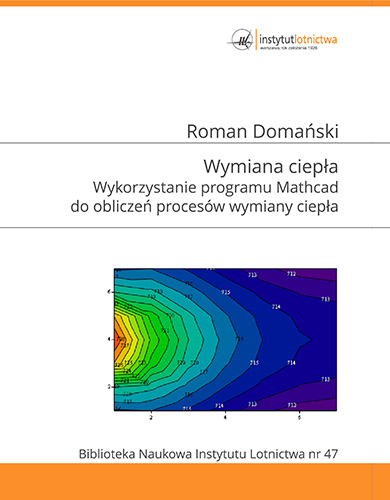Author: Roman Domański
Title: Heat exchange. Using mathcad program to calculate heat exchange processes
ISBN: 978-83-635393-4-4
Cover: paperback, glued binding
The year of publication: 2016
Publisher: Scientific Publishers of the Institute of Aviation
Quantity pages: 346
Language of publication: polish
Description: Energy and processes of its conversion are the basis of our existence and civilization development. The transport of energy in a way of heat is therefore an important element in nature, technology and medicine. The phenomena of heat exchange are very complex and their knowledge is of fundamental importance for the development of new technologies. Experiments on heat transfer are difficult and expensive, and theoretical solutions are possible for simple geometries and boundary conditions,
so simulations and numerical calculations are important.
The dynamic development and miniaturization of microprocessors allows for
a gigantic increase in computing power and thus in the importance of numerical computing. On the market we have many professional programs that can be used to calculate heat exchange processes such as Mathematica, Maple, Derive, Matlab, and also such as Fluent or ANSYS. One of the tools is MathCad. The presented lecture is entirely prepared as a set of programs in MathCad, which at the same time serve as a manual and computational tool. In this way, the basic issues of heat exchange with calculation examples have been worked out. The user can change input data, selected geometrical and material parameters and obtain results for interesting cases. Before each chapter, the basic knowledge and equations in
the classical notation are presented in a very concise way in order to facilitate understanding of the calculations carried out in MathCad.
The paper also presents a wide range of determination of configuration coefficients for radiation issues. Additionally, a number of solutions for selected tasks, including complex heat exchange, are presented.
The prepared set of programs can be very useful for engineers and students as it allows for quick, multi-variant calculations, e.g. for ribs, temperature fields in transient states, or determination of heat transfer coefficients. The presented paper is not
a manual for the use of MathCad, but examples of its applications in the study of heat exchange processes. Due to the organization of the whole work, the drawings are numbered inside the subchapters and in the programs inside the programs. It was not possible to maintain the same numbering throughout the whole work due to programming requirements. Some of the values required to initialize programs are not visible on the printout, but are visible in the MathCad program itself. In some programs, units are not entered, but calculations are performed for the current SI system.
These programs can help you learn MathCad. In order to use the program, the user must install MathCad 15 or higher with a converter. The manual can of course be used as a classic book, and the large number of graphs allows a better understanding of physical problems. The work is based on the experience gained during the preparation of lectures on transitional work, diplomas and research projects. Owners of PTC version MathCad Prime 1.0 and higher have access to the lower version so the programs were not converted to the Prime version. Two extensive examples are presented in MathCad Prime 3.1. The paper also contains
a short addition with properties of selected materials.

